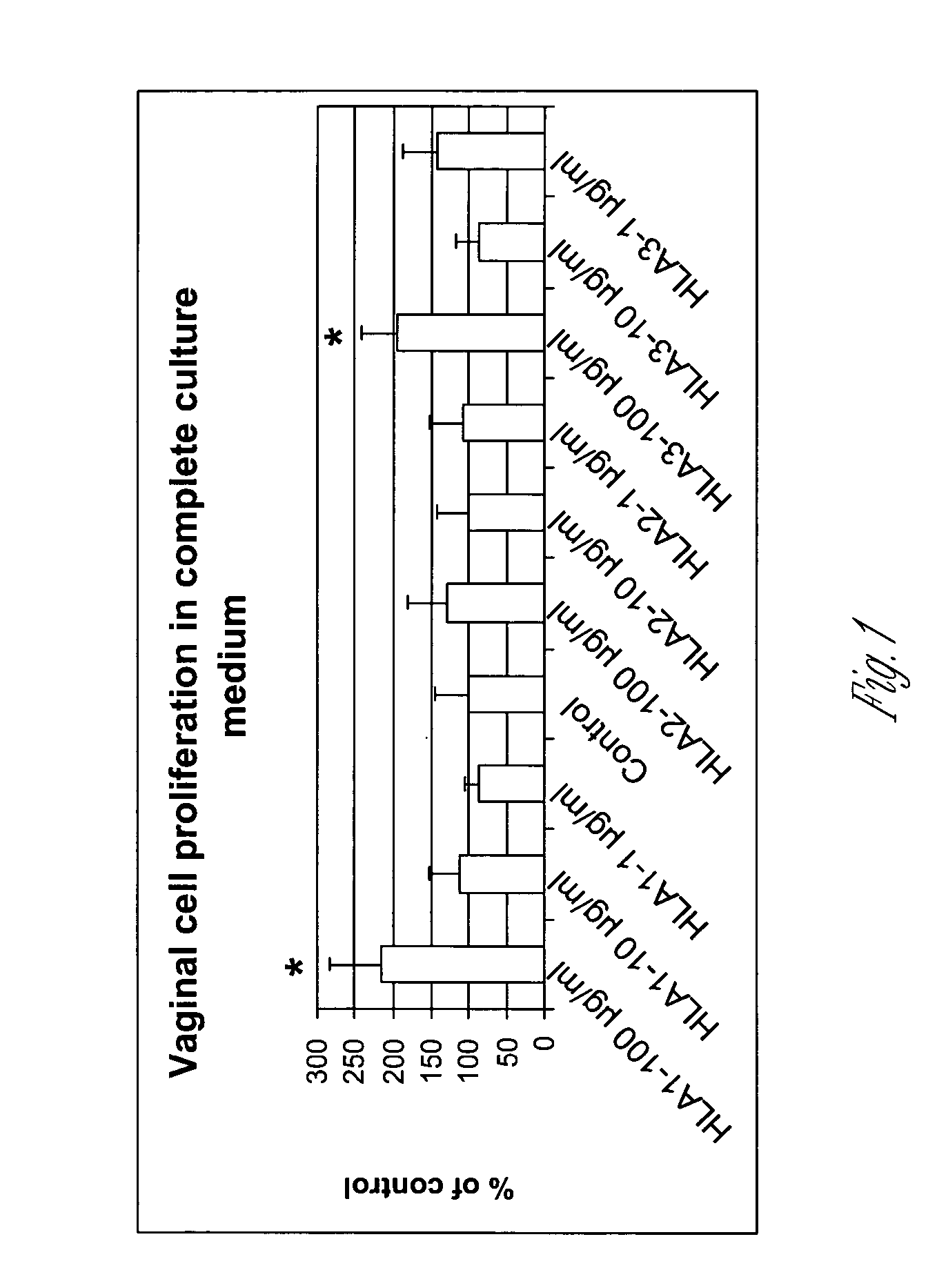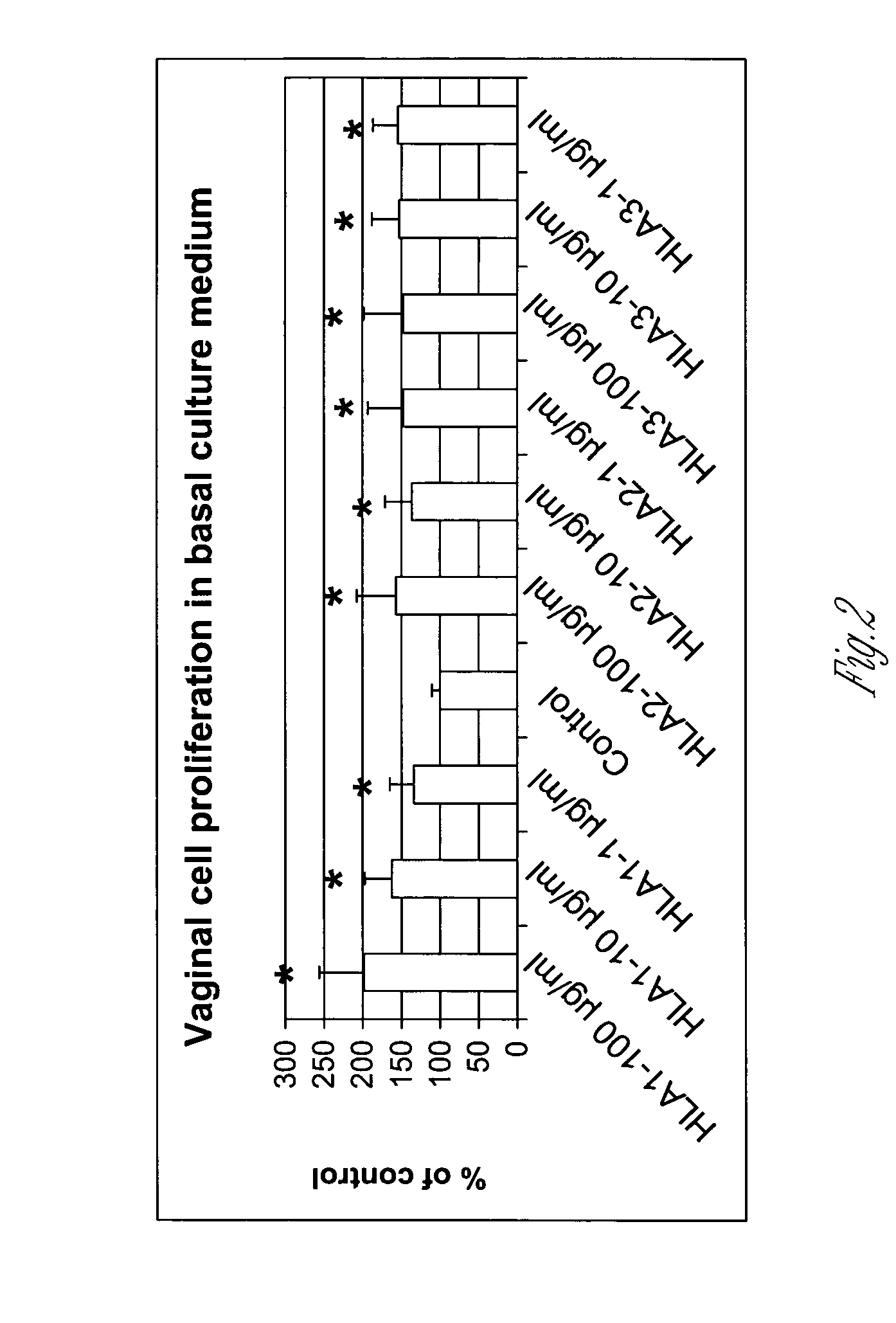Compositions for promoting vaginal cell proliferation and maturation
- Summary
- Abstract
- Description
- Claims
- Application Information
AI Technical Summary
Benefits of technology
Problems solved by technology
Method used
Image
Examples
example 1
Hyaluronic Acid Promotes Vaginal Cell Proliferation
Materials and Methods
[0077] Normal human vaginal epithelial cells from Clonetics (NHVE 5164) were subcultured into 96 well plates at 37° C., 5% CO2. Cells were cultured with basal PrEBM (Clonetics CC 3165) supplemented with cell growth medium bulletKit (Clonetics, cc-3166). Cells were treated with HLA having different molecular weights (MW), HLA1 (Sigma #H1751, intrinsic viscosity=100), HLA2 (MW, 150-500 k, Carbomer #8-01250) and HLA3 (a disaccharide, MW 405, Sigma #H9649). HLA was dissolved in either basal culture medium or basal medium supplemented with growth factors (complete medium) at concentration of 100, 10 or 1 μg / ml. Control group cells were treated with culture medium only. Each treatment group included 6 samples. The media for the different samples were changed 48 hours later and cell proliferation was examined at 72 hours by using CellTiter 96 Aqueous One Solution from Promega (#TB245). Twenty μl of the reagent was a...
example 2
Hyaluronic Acid Promote Glycogen Production of Human Vaginal Cells
[0081] This Example illustrates that hyaluronic acid treatment increases glycogen production in human vaginal cells. Glycogen is produced by the vaginal epithelial cells of intermediate epidermal layers. A decrease in glycogen content is one of the most striking changes in the postmenopausal vaginal epithelium, mainly due to the fact that cells in the parabasal layers fail to further differentiate. Therefore, glycogen content in the vaginal epithelial cell cytoplasm has been used as a differentiation / maturation marker for vaginal epithelial cells.
[0082] Primary vaginal epithelial cells were cultured in 96-well plates. Five samples were tested for each group. Treatment was for 5 days with culture medium solutions (PrEBM, Clonetics CC-3165) without (the control group) and with 0.1 mg / mL hyaluronic acid (Sigma H-1751). The media were changed every other day. At the end the treatment, the media was removed, and the well...
example 3
Hyaluronic Acid Inhibits E. coli Attachment to Human Epithelial Cells
[0094] This Example illustrates that reduced numbers of E. coli attach to substrates containing hyaluronic acid.
Materials and Methods
[0095] Cultured A431 cells were used as a model human epithelial cell line. A431 cells were obtained from American Cell Type Culture Collection, catalog # CRL-1555. A monolayer of A431 cells was grown on a 24-well tissue culture plate until confluent. E. coli with P family pili, ATCC 53505, were cultured in trypticase soy broth (TSB) overnight. Phosphate buffered saline (PBS, control) or hyaluronic acid (Sigma, catalog # H1876) solutions at a concentration of 1 mg / ml or 5 mg / ml in PBS were added to the A431 cell layers, using a volume of 1.2 ml / well. For comparison, a control plate was set up and treated identically as the test plate, except that the wells in the control plate were given PBS without hyaluronic acid. After incubation for 30 minutes at 37° C., 0.5 ml of solution was...
PUM
| Property | Measurement | Unit |
|---|---|---|
| Mass | aaaaa | aaaaa |
| Mass | aaaaa | aaaaa |
| Cell proliferation rate | aaaaa | aaaaa |
Abstract
Description
Claims
Application Information
 Login to View More
Login to View More - R&D
- Intellectual Property
- Life Sciences
- Materials
- Tech Scout
- Unparalleled Data Quality
- Higher Quality Content
- 60% Fewer Hallucinations
Browse by: Latest US Patents, China's latest patents, Technical Efficacy Thesaurus, Application Domain, Technology Topic, Popular Technical Reports.
© 2025 PatSnap. All rights reserved.Legal|Privacy policy|Modern Slavery Act Transparency Statement|Sitemap|About US| Contact US: help@patsnap.com



